Jianbo Yuan
InfiR : Crafting Effective Small Language Models and Multimodal Small Language Models in Reasoning
Feb 17, 2025Abstract:Large Language Models (LLMs) and Multimodal Large Language Models (MLLMs) have made significant advancements in reasoning capabilities. However, they still face challenges such as high computational demands and privacy concerns. This paper focuses on developing efficient Small Language Models (SLMs) and Multimodal Small Language Models (MSLMs) that retain competitive reasoning abilities. We introduce a novel training pipeline that enhances reasoning capabilities and facilitates deployment on edge devices, achieving state-of-the-art performance while minimizing development costs. \InfR~ aims to advance AI systems by improving reasoning, reducing adoption barriers, and addressing privacy concerns through smaller model sizes. Resources are available at https://github. com/Reallm-Labs/InfiR.
Unconstrained Model Merging for Enhanced LLM Reasoning
Oct 17, 2024



Abstract:Recent advancements in building domain-specific large language models (LLMs) have shown remarkable success, especially in tasks requiring reasoning abilities like logical inference over complex relationships and multi-step problem solving. However, creating a powerful all-in-one LLM remains challenging due to the need for proprietary data and vast computational resources. As a resource-friendly alternative, we explore the potential of merging multiple expert models into a single LLM. Existing studies on model merging mainly focus on generalist LLMs instead of domain experts, or the LLMs under the same architecture and size. In this work, we propose an unconstrained model merging framework that accommodates both homogeneous and heterogeneous model architectures with a focus on reasoning tasks. A fine-grained layer-wise weight merging strategy is designed for homogeneous models merging, while heterogeneous model merging is built upon the probabilistic distribution knowledge derived from instruction-response fine-tuning data. Across 7 benchmarks and 9 reasoning-optimized LLMs, we reveal key findings that combinatorial reasoning emerges from merging which surpasses simple additive effects. We propose that unconstrained model merging could serve as a foundation for decentralized LLMs, marking a notable progression from the existing centralized LLM framework. This evolution could enhance wider participation and stimulate additional advancement in the field of artificial intelligence, effectively addressing the constraints posed by centralized models.
BabelBench: An Omni Benchmark for Code-Driven Analysis of Multimodal and Multistructured Data
Oct 01, 2024



Abstract:Large language models (LLMs) have become increasingly pivotal across various domains, especially in handling complex data types. This includes structured data processing, as exemplified by ChartQA and ChatGPT-Ada, and multimodal unstructured data processing as seen in Visual Question Answering (VQA). These areas have attracted significant attention from both industry and academia. Despite this, there remains a lack of unified evaluation methodologies for these diverse data handling scenarios. In response, we introduce BabelBench, an innovative benchmark framework that evaluates the proficiency of LLMs in managing multimodal multistructured data with code execution. BabelBench incorporates a dataset comprising 247 meticulously curated problems that challenge the models with tasks in perception, commonsense reasoning, logical reasoning, and so on. Besides the basic capabilities of multimodal understanding, structured data processing as well as code generation, these tasks demand advanced capabilities in exploration, planning, reasoning and debugging. Our experimental findings on BabelBench indicate that even cutting-edge models like ChatGPT 4 exhibit substantial room for improvement. The insights derived from our comprehensive analysis offer valuable guidance for future research within the community. The benchmark data can be found at https://github.com/FFD8FFE/babelbench.
Law of Vision Representation in MLLMs
Aug 29, 2024



Abstract:We present the "Law of Vision Representation" in multimodal large language models (MLLMs). It reveals a strong correlation between the combination of cross-modal alignment, correspondence in vision representation, and MLLM performance. We quantify the two factors using the cross-modal Alignment and Correspondence score (AC score). Through extensive experiments involving thirteen different vision representation settings and evaluations across eight benchmarks, we find that the AC score is linearly correlated to model performance. By leveraging this relationship, we are able to identify and train the optimal vision representation only, which does not require finetuning the language model every time, resulting in a 99.7% reduction in computational cost.
An Expert is Worth One Token: Synergizing Multiple Expert LLMs as Generalist via Expert Token Routing
Mar 25, 2024
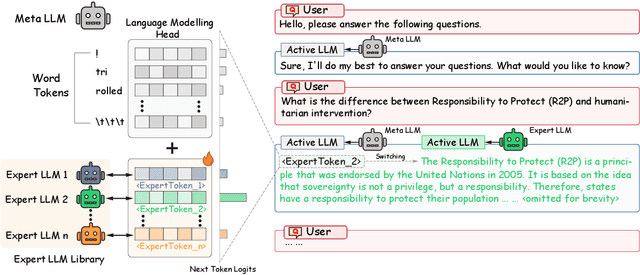
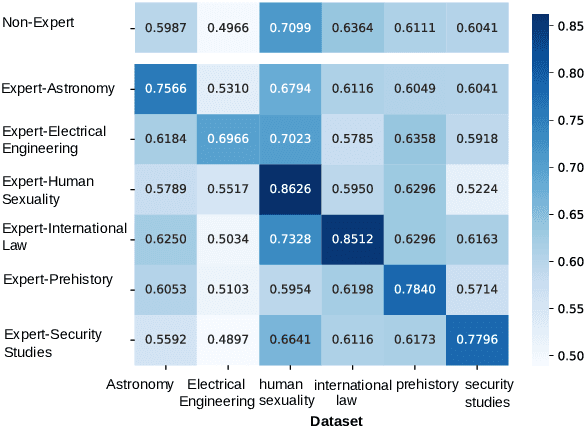

Abstract:We present Expert-Token-Routing, a unified generalist framework that facilitates seamless integration of multiple expert LLMs. Our framework represents expert LLMs as special expert tokens within the vocabulary of a meta LLM. The meta LLM can route to an expert LLM like generating new tokens. Expert-Token-Routing not only supports learning the implicit expertise of expert LLMs from existing instruction dataset but also allows for dynamic extension of new expert LLMs in a plug-and-play manner. It also conceals the detailed collaboration process from the user's perspective, facilitating interaction as though it were a singular LLM. Our framework outperforms various existing multi-LLM collaboration paradigms across benchmarks that incorporate six diverse expert domains, demonstrating effectiveness and robustness in building generalist LLM system via synergizing multiple expert LLMs.
How Can LLM Guide RL? A Value-Based Approach
Feb 25, 2024Abstract:Reinforcement learning (RL) has become the de facto standard practice for sequential decision-making problems by improving future acting policies with feedback. However, RL algorithms may require extensive trial-and-error interactions to collect useful feedback for improvement. On the other hand, recent developments in large language models (LLMs) have showcased impressive capabilities in language understanding and generation, yet they fall short in exploration and self-improvement capabilities for planning tasks, lacking the ability to autonomously refine their responses based on feedback. Therefore, in this paper, we study how the policy prior provided by the LLM can enhance the sample efficiency of RL algorithms. Specifically, we develop an algorithm named LINVIT that incorporates LLM guidance as a regularization factor in value-based RL, leading to significant reductions in the amount of data needed for learning, particularly when the difference between the ideal policy and the LLM-informed policy is small, which suggests that the initial policy is close to optimal, reducing the need for further exploration. Additionally, we present a practical algorithm SLINVIT that simplifies the construction of the value function and employs subgoals to reduce the search complexity. Our experiments across three interactive environments ALFWorld, InterCode, and BlocksWorld demonstrate that our method achieves state-of-the-art success rates and also surpasses previous RL and LLM approaches in terms of sample efficiency. Our code is available at https://github.com/agentification/Language-Integrated-VI.
Exploring the Reasoning Abilities of Multimodal Large Language Models (MLLMs): A Comprehensive Survey on Emerging Trends in Multimodal Reasoning
Jan 18, 2024



Abstract:Strong Artificial Intelligence (Strong AI) or Artificial General Intelligence (AGI) with abstract reasoning ability is the goal of next-generation AI. Recent advancements in Large Language Models (LLMs), along with the emerging field of Multimodal Large Language Models (MLLMs), have demonstrated impressive capabilities across a wide range of multimodal tasks and applications. Particularly, various MLLMs, each with distinct model architectures, training data, and training stages, have been evaluated across a broad range of MLLM benchmarks. These studies have, to varying degrees, revealed different aspects of the current capabilities of MLLMs. However, the reasoning abilities of MLLMs have not been systematically investigated. In this survey, we comprehensively review the existing evaluation protocols of multimodal reasoning, categorize and illustrate the frontiers of MLLMs, introduce recent trends in applications of MLLMs on reasoning-intensive tasks, and finally discuss current practices and future directions. We believe our survey establishes a solid base and sheds light on this important topic, multimodal reasoning.
InfiAgent-DABench: Evaluating Agents on Data Analysis Tasks
Jan 10, 2024Abstract:In this paper, we introduce "InfiAgent-DABench", the first benchmark specifically designed to evaluate LLM-based agents in data analysis tasks. This benchmark contains DAEval, a dataset consisting of 311 data analysis questions derived from 55 CSV files, and an agent framework to evaluate LLMs as data analysis agents. We adopt a format-prompting technique, ensuring questions to be closed-form that can be automatically evaluated. Our extensive benchmarking of 23 state-of-the-art LLMs uncovers the current challenges encountered in data analysis tasks. In addition, we have developed DAAgent, a specialized agent trained on instruction-tuning datasets. Evaluation datasets and toolkits for InfiAgent-DABench are released at https://github.com/InfiAgent/InfiAgent.
InfiMM-Eval: Complex Open-Ended Reasoning Evaluation For Multi-Modal Large Language Models
Dec 04, 2023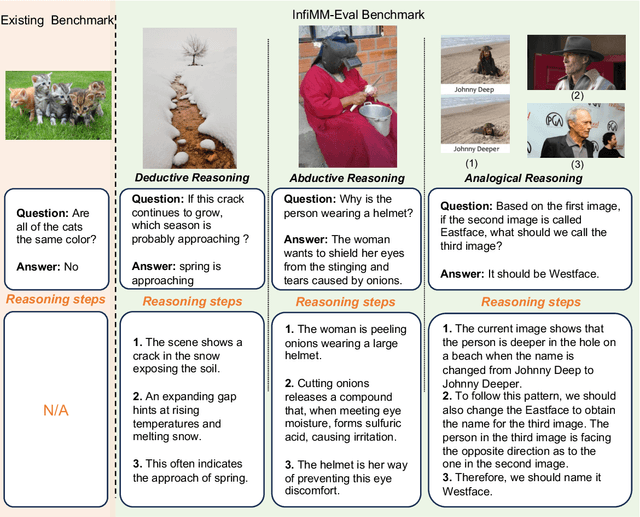
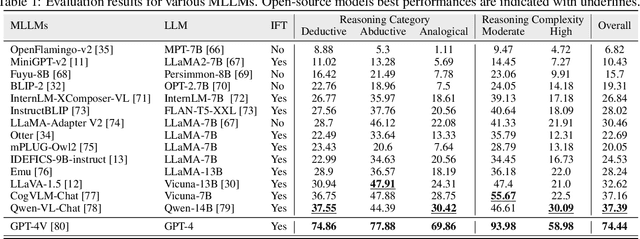
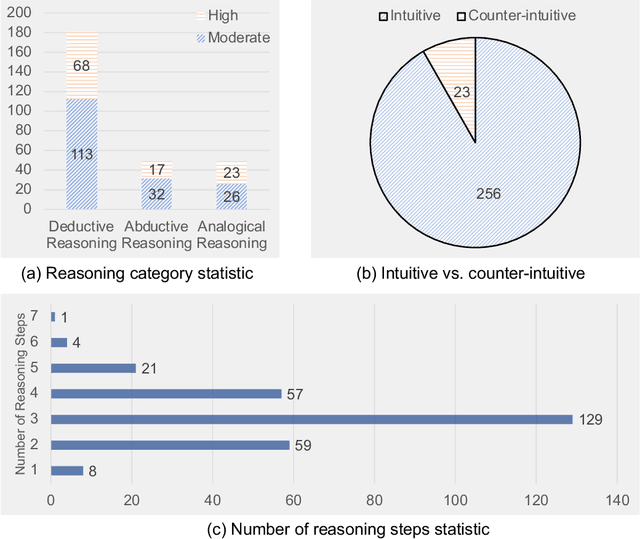
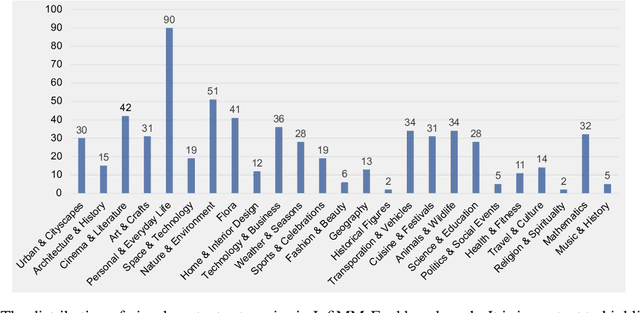
Abstract:Multi-modal Large Language Models (MLLMs) are increasingly prominent in the field of artificial intelligence. These models not only excel in traditional vision-language tasks but also demonstrate impressive performance in contemporary multi-modal benchmarks. Although many of these benchmarks attempt to holistically evaluate MLLMs, they typically concentrate on basic reasoning tasks, often yielding only simple yes/no or multi-choice responses. These methods naturally lead to confusion and difficulties in conclusively determining the reasoning capabilities of MLLMs. To mitigate this issue, we manually curate a benchmark dataset specifically designed for MLLMs, with a focus on complex reasoning tasks. Our benchmark comprises three key reasoning categories: deductive, abductive, and analogical reasoning. The queries in our dataset are intentionally constructed to engage the reasoning capabilities of MLLMs in the process of generating answers. For a fair comparison across various MLLMs, we incorporate intermediate reasoning steps into our evaluation criteria. In instances where an MLLM is unable to produce a definitive answer, its reasoning ability is evaluated by requesting intermediate reasoning steps. If these steps align with our manual annotations, appropriate scores are assigned. This evaluation scheme resembles methods commonly used in human assessments, such as exams or assignments, and represents what we consider a more effective assessment technique compared with existing benchmarks. We evaluate a selection of representative MLLMs using this rigorously developed open-ended multi-step elaborate reasoning benchmark, designed to challenge and accurately measure their reasoning capabilities. The code and data will be released at https://infimm.github.io/InfiMM-Eval/
Improving In-Context Learning in Diffusion Models with Visual Context-Modulated Prompts
Dec 03, 2023



Abstract:In light of the remarkable success of in-context learning in large language models, its potential extension to the vision domain, particularly with visual foundation models like Stable Diffusion, has sparked considerable interest. Existing approaches in visual in-context learning frequently face hurdles such as expensive pretraining, limiting frameworks, inadequate visual comprehension, and limited adaptability to new tasks. In response to these challenges, we introduce improved Prompt Diffusion (iPromptDiff) in this study. iPromptDiff integrates an end-to-end trained vision encoder that converts visual context into an embedding vector. This vector is subsequently used to modulate the token embeddings of text prompts. We show that a diffusion-based vision foundation model, when equipped with this visual context-modulated text guidance and a standard ControlNet structure, exhibits versatility and robustness across a variety of training tasks and excels in in-context learning for novel vision tasks, such as normal-to-image or image-to-line transformations. The effectiveness of these capabilities relies heavily on a deep visual understanding, which is achieved through relevant visual demonstrations processed by our proposed in-context learning architecture.
 Add to Chrome
Add to Chrome Add to Firefox
Add to Firefox Add to Edge
Add to Edge